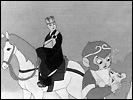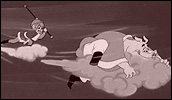Journey to the West
- Year
- 1960
- Original title
- Saiyuki
- Japanese title
- 西遊記
- Alternative title
- Alakazam the Great
- The Enchanted Monkey
- The Magic Land of Alakazam
- Director
- Cast
- Running time
- 88 minutes
- Published
- 23 September 2004



by Jasper Sharp
For the subject matter of the third feature-length colour animation ever produced in Japan (after The Legend of the White Serpent / Hakujaden in 1958, and Magic Boy / Shonen Sarutobi Sasuke in 1959 - both directed by Taiji Yabushita), Toei Animation turned, as they had with Legend of the White Serpent, to a Chinese source, this time to the 16th-century classic of Chinese literature Xiyouji or Journey to the West by Wu Cheng'en. The original story recounted the adventures of a young priest travelling to India charged with the task of bringing back Buddhist sutras to China, assisted by a motley crew of a monkey, a gluttonous pig-man, and a fallen monk.
By the time of Toei's rendition, the story had already formed the basis of a number of film versions in Japan, beginning with the short paper cut-out animation of Noboro Ofuji's Saiyuki Songoku Monogatari in 1926, and following on through Takahiro Ishikawa's Songoku in 1928 and Minoru Ishiyama's Saiyuki: Songoku in 1936, amongst others. The simian protagonist Songoku, the monkey who dared to be more than human and was punished by the gods for his arrogance, also featured in a number of short Japanese animations around the late 30s, and even now, is a common anime character name, for example, in series such as Dragon Ball. British and Austrian viewers who grew up in the 1970s will no doubt remember the story better through the flamboyant live action NHK TV series that aired on both BBC and ABC in a ridiculously-dubbed version known as Monkey. And if all this wasn't enough, the book has also been adapted on a number of occasions in both China and Hong Kong, including two live action versions from the Shaw Brothers directed by Meng-Hwa Ho in 1966, Monkey Goes West and Princess Iron Fan.
For its all-new colour incarnation, Toei enlisted the services of the man most commonly attributed to elevating the status and popularity of the comic book in Japan to the levels it enjoys today, Osamu Tezuka, to help adapt his own 1952 manga version of the tale Boku no Songoku [trans: My Songoku], though the script was actually written by Keinosuke Uegusa, who was also behind, believe it or not, the screenplay of Akira Kurosawa's 1948 film Drunken Angel. Tezuka's manga was itself inspired by a 1941 animated version produced in China by the Wan brothers (Wan Laiming, Wan Guchan, and Wan Chaochen) that had been released in Japan during the war.
Set way back in the distant past, Journey to the West begins with a pair of angels gazing down from their celestial golden cloud surveying events way down below on earth and immediately singling out the figure of solitary monkey wandering through a forest grove as a potential troublemaker. The monkey, born from a rock by the ocean, soon stumbles into the fair primate Rin Rin, but having never had any parents, has never been given a name and is unsure of how to introduce himself. By the time Rin Rin has brought him home to the tribe of apes to which she belongs and become his sweetheart, he has sufficiently grown in confidence to announce himself as Songoku, or "Awakened to Emptiness", and immediately sets designs on claiming the crown of the Monkey King for himself.
Songoku's rise to the position of top monkey is a fairly trouble-free process, so when he discovers that such a creature known as "man" exists, he leaves his tribe in search of immortality and magic power in order to ascend even higher in the world's pecking order. However, the first application of his new skills incurs the wrath of the gods when he arrogantly flies skywards to steal the Heavenly Peaches to present to his darling Rin Rin. Despite managing to make off from heaven with a magic fighting staff that changes in size on command, for his presumptuousness he is imprisoned in a sealed-off cave in the peak of a remote mountain by none other than Buddha himself. Fortunately he is offered a chance of redemption from a passing Priest, Sanzohoshi (a.k.a. Tripitaka), who enlists Songoku's help in journeying to India to retrieve the Buddhist sutras, placing a golden headband around his skull to curb his impetuous nature. En route, they come across a small village, where the village headman's daughter is currently receiving a lot of attention from a spirit in the shape of a pig-headed man.
Journey to the West cracks off at an incredibly fast pace and barely lets up for its entire duration, carrying the viewer through a dense, episodic-ridden plot, which, in keeping with the manga, only focuses on certain episodes within the original story. This source material not only forms the basis of the narrative, but also its design - scarcely surprising as Tezuka was responsible for designing the storyboards.
Like a lot of Tezuka's work, Journey to the West comes across as rather a bizarre mish-mash of styles, both story-wise and visually drawing on both Asian and European mythologies, as well as spicing things up with some more anachronistic elements conjured up from his own fertile imagination. When Songoku attempts to seize the Heavenly Peaches, a squadron of heavenly police guards arrive on clouds to stop him, kitted out with white uniforms and face masks, spotlights and staffs. He fends them off, only to be confronted by a further guardian in the guise of an ancient Greek warrior. As they do battle, the pair transmogrify into a series of wild beasts, before settling into their final forms of a dragon and a lion. Featuring heavily later on in the tale is the character of a mischievous sprite who contacts his bull-headed demonic master by a telephone and video screen utilising his solitary, unicorn-like horn as an antenna.
Of course, the main shadow hanging over a lot of Toei Animation's work at this time was that of Disney. It's true, there was little chance of matching the scale of Disney's finely-crafted masterpieces at this time, but what the studios lacked in financial resource in the decades after the war, they more than made up for in ambition. Whilst events onscreen always remain remarkably "busy"-looking, in terms of the fluidity of its animation Journey to the West is certainly not up to the standards of its US role models. But if one compares it to the work that came before The Legend of the White Serpent, one can see that the bar was being raised continuously as Toei Animation strived for that same cross-cultural, cross-generational appeal of Disney, albeit using more Asian scenarios. Looking at the handful of musical numbers among the tribe of monkeys occurring in the opening scenes, it comes as some shock to realise that Toei's movie preceded Disney's The Jungle Book (Wolfgang Reitherman, 1967) by seven years.
Journey to the West was actually released in the US in 1961 in a dubbed version, under the title of Alakazam the Great, with Songoku renamed as Alakazam, Frankie Avalon contributing his voice to the singing parts, and the names of all the characters and locations changed enough to render any traces of its Buddhist origins almost completely untraceable. The film was recently put out in an unsubtitled version in Japan, but the current unavailability of much of Toei Animation's work in any format accessible to English speakers has thus far hampered any Western appreciation of the company's role in the historical development of world animation. In a year in which the Japanese film industry finally seems to be awakening to the centrality of anime as a major cultural export, perhaps it's only a matter of time before this and many other critical works from the period prior to the 70s finally become available in export versions.
Journey to the West was Tezuka's first experience in the world of animation, but it proved positive enough to inspire this legendary figure of the manga art form to found his own company in 1961. Tezuka's animation studio, which he called Mushi Pro ("mushi" means insect - the kanji can also be read as "mu", and is one of the characters used to write Tezuka's first name, OsaMU), is fondly remembered for its early TV adaptations of Tezuka's famous creation Tetsuwan Atom, or Astro Boy, which began broadcasting in 1963.
Meanwhile, Taiji Yabushita, the supervisor behind some of Toei's biggest projects during this time, collaborated with Tezuka again on Arabian Nights (Arabian Naito - Shindobaddo no Boken), released in 1961. Yabushita's next work, Wan Wan Chushingura (1963), based on an original idea by Tezuka, would also prove a historic landmark in Japanese animation. It was the first major animated feature that Ghibli's Hayao Miyazaki would work on, in the relatively lowly position of an "in-betweener", the person who draws the pictures between the key frames.